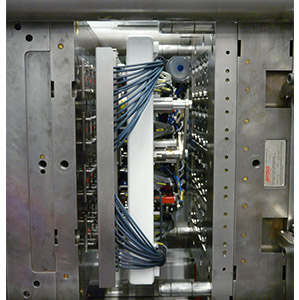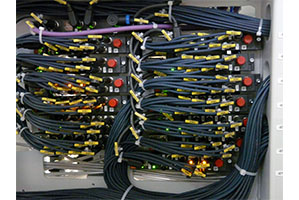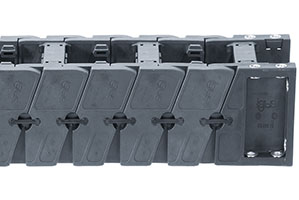Optimised stranded wire and multiple braiding absorbs forces
The entire chainflex product line was developed from the ground up for use in energy chains. For this reason, only optimised strands are used in the individual conductors. These strands are neither too thin nor too thick. The individual conductors are wrapped into a cable in a way that prevents "corkscrews" and is capable of optimally absorbing the forces that occur. This is attained through short pitch of the strands and, for twelve of more conductors, through what is known as braiding in bundles, in which the conductors are first braided in a short pitch and the resulting bundles are, in turn, braided to make a complete structure. This structure is created around a tensile stress-resistant centre element. This may sound overly elaborate, but it is worth the effort. The braiding remains stable, even at the highest bending stress and with high dynamics. All showcased by the impressive demonstration of chainflex cables in use in Hekuma systems.
Moving cables in high-speed use
igus energy chain systems in Hekuma plants
Hekuma high-performance automation systems for the plastics industry work with cycle times in the second range. For the energy supply of the grippers, this means that the first million strokes are reached after just four to six weeks - in rough environmental conditions including heat, high acceleration and motion in two axes. In these areas, igus chainflex® cables prove their value and are subjected to loads almost as high as those in the igus in-house test lab.
Fast – faster – the fastest: In this continuum, Hekuma's systems are, without a doubt, some of the fastest anywhere. The company,
based in the Munich suburb of Eching, is known for high-performance and maximum-performance automation of injection moulding processes.
"We want to be the fastest"
Hekuma develops and manufactures complete systems for plastics processing used primarily in medical technology, the automotive industry and in consumer goods production. Usually, injection moulding machines are located at the centre of the systems, and Hekuma's task is to automate not only demoulding, but also upstream and downstream processes such as punching contacts or inserting these punched parts into the injection mould.
Hekuma systems all have one thing in common: they work at extreme speeds. Electronic design engineer Holger Weber explains, "Our typical cycle times are about four to six seconds, and in some cases, we reach demoulding times of less than one second. “ Currently, Hekuma is supplying a system with a 64-cavity mould for producing laboratory specimen holders with a cycle time of 5.5 seconds.

The demoulding robot moves into the open mould and typically has three to six seconds for the complete cycle. This places extreme strain on the electrical cables. (Source: igus GmbH).
Simply because of the high production rate, avoiding downtime is imperative. A failure of just a few minutes quickly results in tens of thousands of faulty parts.

The high number of cables places stringent requirements on their availability. All that needs to happen is for one cable to break and the machine shuts down. chainflex CF9 cables ensure high productivity. (Source: igus GmbH).
At the limits of mechanical engineering
From the standpoint of Hekuma's design engineers, the high rate of production on the systems means that in many cases, limits are imposed by the mechanical system. In many cases, however, the electronics set the limits. Therefore, the latest and greatest IPC control systems with the shortest processing speeds are used throughout. Without this high performance, it would be impossible to achieve cycle times of two or three seconds. Thus we might say that Hekuma is pushing mechanical engineering to the (speed) limit. And this might prompt us to ask just what cables and energy chains the grippers are equipped with.
The perfect cable for high-speed robotics
Obviously, standard cables are not nearly good enough for this application. At the typical cycle times, several million double strokes take place within a few short months and at very high accelerations of up to 10 g. Under this strain, a conventional cable would fail after just a few days. Hekuma chose a solution that lasts for years. Weber elaborates, "For about ten years now, we've been using cables from the igus chainflex product range. Our standard in-house cable is the CF9 series with cross sections from 0.25 to 0.34 mm2 as an INI cable. We've had great experience with this cable. “

The chainflex CF9 is the high-end cable in the igus standard product line - developed for extreme dynamic loads. A shielded variant is also available from stock as the CF10 series. (Source: igus GmbH).
High-end quality from the standard product line
Though the CF9 series used by Hekuma is part of igus' standard product line, chainflex offers a wide variety of options within the standard. Reliable cables are available both for applications with a large radius and fewer cycles as well as for the smallest radii. The CF9 used here is at the high end of the product line. Users who want even more heavy-duty cables can use solutions with special alloys that withstand the loads even within a radius of 4xd. However, like other customers with extremely high standards, Hekuma is completely satisfied with the characteristic profile of the CF9. The jacket, made of special abrasion-resistant TPE, features excellent abrasion-resistance properties. In terms of performance, dynamics and speed, the cable is ideally suited to Hekuma's requirements. The small bending radius of 5xd is entirely sufficient. Notes Weber explains, "Small bending radii are critical for us, because space for tool and workpiece handling is often extremely limited. We also know that if we needed to, we could look into additional options at igus if our requirements were to increase even more. “
E6 chain for cable guidance
Some of the moving cables are arranged exposed, but most at the main axes are in chains. Here, Hekuma has chosen the E6 series from igus as the standard system. It goes without saying that the requirements for the chains are no less stringent than those for the cables. Weber explains, "Due to the very short cycles, constant vibrations occur in the cable system that act like short bumps. This results in very great strain on the chain and cable, quite unlike that for constant unwinding movements. “
The system illustrated here gives an impression of the motion sequences the energy chain and the chainflex must withstand, and how often.

Hekuma uses chainflex CF9 cables in combination with igus E6 energy chains. (Source: igus GmbH).
The heavy injection mould is open all the way for just 0.8 seconds. Within this short span of time, the gripper must plunge into the mould, then remove the finished plastic parts with a motion in the second axis before the mould closes for the next shot.
The high packing density of the cables also illustrates the important role of the drive and (above all) the control engineering here. Hekuma is at the forefront when it comes to sounding out new possibilities. This pertains to introducing new technologies during processing and installation as well as the basics of automation technology. Weber notes that, "We want to be at the vanguard and integrate even more electronics and sensors in the future, such as for condition analysis for machine components. " The reliable energy supply is definitely covered. At even higher dynamics, the CF9 lines and E6 energy chains provide a system for absolute high-speed automation.